Mount Hood
25 September 1970
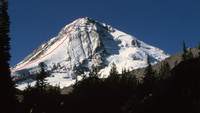
Mount Hood
is the fourth highest of the Cascade volcanoes at 11,240 feet
(Mount Rainier, Mount Shasta and Mount Adams being higher).
After our aborted Winter attempt,
we decided to climb in the Fall and stay overnight on the summit.
We were careful to discretely tell a few friends of our plans and not
advertise it widely because there is a well-known
story
around the Cascades of a group who made a big deal of camping overnight
on the summit of Hood,
only to awaken the next morning to find a bottle of milk and that
morning's newspaper outside their tent door.
Mount Hood is not a particularly difficult mountain to climb,
but has a relatively high fatality rate because its easy access attracts
unqualified hikers and climbers.
The route we chose was
Cooper Spur
(marked in red),
which is of median difficulty for the mountain and definitely not a
“tourist route.”
The
steep
slopes
near the summit and rockfall are two major threats.
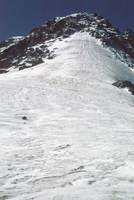
Looking 2,500 feet up Cooper Spur,
one sees how the slope increases in steepness as one approaches the summit.
The usually dirty slopes of Fall have been made clean by a recent snowfall.
For a sense of scale,
take note of two of our party ahead of us immediately above and left of
the center of the picture.
Also note the large rock that fell off the mountain and came to rest
between us and them some time in the recent past.
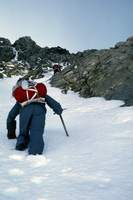
As one gets into the rocks above the snow slope,
the route becomes a matter of weaving through the rock outcrops.
Late in the year,
this is typically steep,
rotten rock but early season snowfall had covered the route with enough
snow that we were using crampons and ice axes.
We were roped up in pairs here;
the going seemed easy and there were plenty of opportunities to find a
comfortable place on a rock to secure each other.
The slope increases as one nears the summit,
and we made our belays more secure the last several hundred feet
through the
“Chimneys.”
The route ends suddenly with a sharp transition from steep snow and rock
to a flat plain near the summit mound.
After scrambling to the summit and returning to the flat area,
we met a lone man wearing tennis shoes and light clothing,
carrying only an empty water bottle.
He had come up the easy route.
This is a good example of why there are so many injuries and deaths on
the mountain.
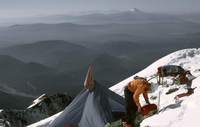
The wind had been fierce during the day so we hacked out a platform in a
sheltered area near the summit and anchored the tent well.
As the sun got lower in the west the wind died down and we were able to
prepare dinner and enjoy a very peaceful night,
with occasional whiffs of sulphur from nearby volcanic vents.
The next morning dawned clear and calm so we could enjoy a nice breakfast
followed by a leisurely
(and safe)
climb down the route we had climbed up.
Of course,
once we were safely down,
we advertised our exploits far and wide.
All in all,
the climb was pleasant and without surprises.
However,
as was common on volcano climbs at the time,
we did not wear helmets.
In retrospect that seems like a bad idea.
A Winter Attempt
Winter, 1970 (?)
Whenever there are news reports of climbers lost or stranded on Mount Hood
in the Winter,
I like to tell people that we had an advantage those people do not:
we did not have cell phones,
GPS or
locator beacons.
We very aware that we were solely responsible for our safety,
and acted accordingly.
A Winter attempt on Mount Hood is typically less challenging than
Mount Rainier,
but weather can be fierce and it shares the same difficulties of
gathering a team and setting a date.
Add to this the fact that it is a much longer drive from/to Seattle,
making a weekend climb more tiring.
Dave Christensen and I managed to interest three others in an attempt
over a weekend late in Winter.
To save time and energy,
the plan was to drive to
Timberline Lodge
ski area,
take a late chair up to about 7,000 feet,
hike up a short way and spend a night so we could get an early start for
the summit.
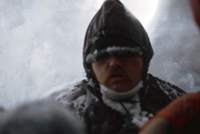
At our chosen camp spot we dug snow caves because that would be much
more secure and comfortable than tents.
I dug a cave with two others while Dave dug a cave with one other.
Unfortunately,
my group hit rock before we could create a cave large enough for the
three of us,
while Dave was able to create a cave suitable for three;
I prevailed upon him to let me join him.
The cave was a bit cramped but otherwise comfortable.
The next morning we woke to a blizzard.
I was first out of the cave and immediately felt like the wind was
sucking the breath out of my body.
I ducked back into the cave and warned the others to be prepared for the
shock.
Visibility was poor but we knew how to get back:
just follow the ridge we had come up until we could intersect some sign
of the ski area.
We considered roping up so we would not lose each other,
but decided that avalanches were a greater hazard and the rope would
pull us all down if one person was carried away.
We resolved to stick together without the rope and headed down,
going down slopes one at a time from one safe spot to the next in case
of avalanche.
We stayed on the ridge until we were sure we were below the level of the
lifts,
then headed down slopes to our left to intersect a ski lift.
The wind was still fierce;
I felt something large in my pockets and stuck my hands in to find them
packed with snow blown by the wind.
I emptied the snow;
within 5 minutes they were packed again.
We soon crossed a ski lift,
and followed it to the lodge.
The weather was so bad the ski area was not open and the lodge was
packed with skiers;
we must have looked strange coming in literally coated in ice.
One of the skiers approached me and asked
“Hey, do you think they will open the ski area today?”
I wondered why he would want to venture out after seeing our condition.
When I opened my pack,
I found every empty space in it was packed with snow.




